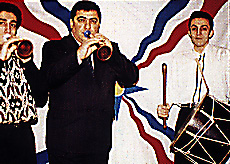Assyrian music
| Assyrian people |
|---|
 |
| Culture |
| Music |
| Language |
| Cuisine |
| Folk Dance |
| Religion |
| Clothing |
| Settlements |
| Tribes |
Assyrian music is divided into three main sections or periods. The Ancient Period consists of that of Ur, Babylon and Nineveh). The remaining periods are the Middle or Tribal Folkloric period and the Modern Period.
History
Ancient Period
Mesopotamia has produced written evidence supporting the existence of sophisticated music theory and practice in the Ur, Babylon and Nineveh cultures. Inscribed tablets have been found with specific tuning modes, string names and hymns.
The discovery of numerous musical instruments in royal burial sites, such as The Golden Lyre of Ur, c. 2650 BC, helps illustrate the prominent role music played in Mesopotamian life and religion. The tunings were known there as early as 3500 B.C.E. Musicians and their instruments appear frequently in the artwork and archaeological artifacts of Iraq's deep antiquity. Among the instruments you will find illustrated are Percussion Instruments (Drums, Timbrels and Rattles); Wind Instruments (Flutes, Pipes and Horns); and String Instruments (Harps, Lyres and Lutes.)
The Syriac Churches have a musical system based on ancient principals today known as ‘Makam’, there are 8 makams used in the church and these are known as Kadmaya(Makam Bayati,Makam Ussak), Trayona, Tlithoya, Rbia(Makam Rast)’ya, Khmshaya, Sitithoya, Shibaya and Timinoya(Makam Hijaz) (in order from one to eight). The most predominant works of the Syriac Churches music was collected in an anthology book named Beth Gazo (Psalms of the treasury of Makams). There are also musical psalms other than this repertoire of 700 psalms, among them are the Fenqitho of the Syriac Orthodox and Maronite Churches, as well as the Khudra of the Church of the East.
One year is divided into eight weeks according to the Church calendar and the first period starts eight Sundays before Christmas. Every Sunday, the prayers in the Psalms are read with one of the Makam.
It is important to note that the ancient Assyrians had special hymns and prayers performed in their Temples by the priesthood on special occasions. Many of these survived in the OT and in the traditional Syriac religious Music.
Tribal Folkloric period

A few types of tribal Assyrian Music that has survived to this day.[citation needed] The following types can still be seen in Northern Iraq and Syria.
- Rawey: A mainly love songs with a story-tale structure, which may include about daily life, suffering and pain.
- Diwani: Sung in gatherings or meetings, lyrics cover aspect of life such as; persecution, Suffering or religion.
- Liliana: A wedding song, usually sung by women only, especially for the bride before leaving her home to get married. Also sung by the bridegroom the day before his wedding by his family and relatives.
- Dowlah and Zornah(Halay):Two traditional music instruments, literally meaning a drum and wind-pipe (or flute). Played together usually with no songs, in many ceremonies such as; weddings, funerals and welcoming (however for funerals played for unmarried men, accompanied by singing).
Today's Music
Assyrian music holds a special place in the hearts of all Assyrians whether it be at a festival, wedding or any other celebration. The patterns played in Assyrian music on these celebrations are usually found in a 6/8 metre such as the famous Khigga or the Sheikhani.
The main instruments are the Dhol or Davul (pronounced "Dawoola" in Assyrian) & Zurna (a type of Oboe), Tambura (similar to the Bouzouki), Baglama, Çiftelia , Dutar, Saz, Watariyat (which consists of Stringed Instruments) & Solo Leads (usually played on a Musical keyboard).
World War One drove Assyrians out from their mountainous region of Hakkaree (South East Turkey) back into Iraq, and World War II brought them in direct contact with the west, especially the British army in Iraq. This contact caused a strong influence on modern Assyrian music, especially the period after the independence of Iraq in 1932. Assyrian youth started picking up and playing new "Western" instruments after seeing and hearing the British playing in Army parades. Ewan Shamdinany was the first who released a modern Assyrian music LP with full western instrumental band in the 1950s, and could be considered the father of Modern Assyrian Music. Another figure who has put a strong infuence in modern Assyrian music is Evin Aghassi.
Assyrian music today share similarities with majorly with Armenian, Persian, Arabic, Turkish and Kurdish music.
See also
Performers and composers
- Complete list: List of Assyrian musicians.
- Aboud Zazi
- Ashur Bet-Sargis
- Evin Agassi
- Linda George
- Janan Sawa
- Juliana Jendo
- Nawfal Shamoun
- Sargon Gabriel
- Shamiram Urshan
- William Nisan
- Ashur Baba
